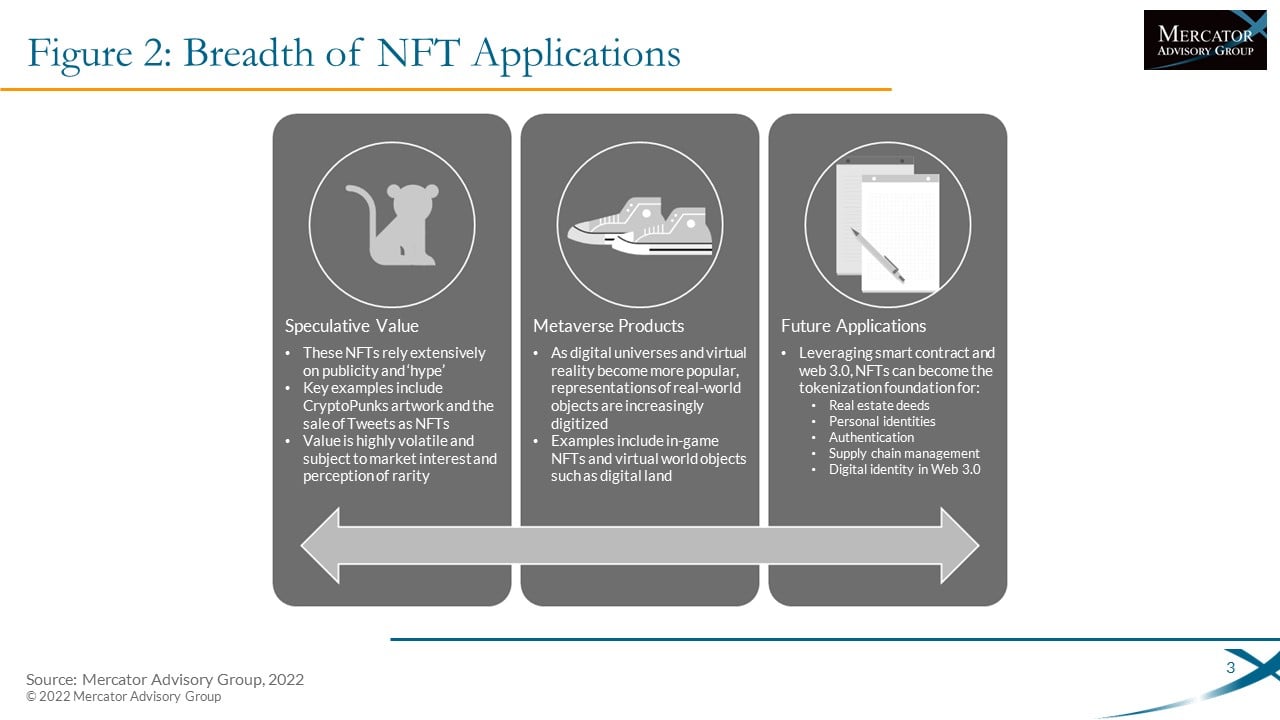Overview
NFTs Will Drive Net New Spending Across a Wide Business and Consumer Demographic, but FIs Need to Mitigate Criminal Activity
New Mercator research delivers an in-depth look at what NFTs are and how various markets will impact your existing account holders. Mercator identifies the risks associated with most existing NFT platforms and suggests mechanisms the financial industry could implement to reduce those risks, both for themselves and for all those consumers who decide to participate in this market.
Given the high visibility of NFTs in the popular press, it is unlikely many of your customer’s haven’t already heard about them. It is also likely many of your customers will be very interested in how they can use them. After all, 33 to 40 percent of Americans are active collectors and collections can be monetized using NFTs. There are also 2 million artists and 179 million monthly gamers in the U.S., all of whom are potential NFT participants and are probably among your account holders.
“This research identifies how NFTs work, the markets that will be impacted first, and why criminal activity has yet to be thwarted, which makes participation by regulated entities risky. We also identify approaches regulated entities can take to reduce risk and identify fraud, and benefit the NFT participants,” commented Tim Sloane, Vice President of Payments Innovation and Director of the Emerging Technology Services Practice at Mercator Advisory Group. “If your financial institution doesn’t address the approaching NFT needs of your customers, they may simply move all their assets to someplace that does”.
This report is 25 pages long and has 3 exhibits.
Companies and other organizations mentioned in this report: Adidas, American Express, Artist-in-Residence Program, Binance, Bored Ape Yacht Club, Cent, Chainalysis, CipherTrace, Cloud Security Alliance, Coca-Cola, Coinbase, Crypto.com, Decentraland, Disney, DraftKings, Drife, Elliptic, Ethereum, Fanaply, FIS, Fiserv, Flyfish Club, Gucci, IBM, Jack Henry, JPMorgan Chase, KnownOrigin, Larva Labs, Mastercard, McDonald’s, Mintable, NBA Top Shot, New York Stock Exchange, Nifty Gateway, Nike, OpenSea, Oracle, Original Penguin, Polygon, Prada, Rarible, Ray-Ban, Solana, Sorare, StockX, Stripe, SuperRare, Taco Bell, The New York Times, The Sandbox, Under Armour, Visa, Zora.
One of the exhibits included in this document:

Highlights of this document include:
- History, in which these were first defined as blockchain applications
- An explanation of what an NFT is and how it functions
- An up-close look at several use cases, including copyrights, identity, marketing, artwork, and Web3
- A deep dive into smart contracts and how they function
- The implementation of NFT exchanges
- The minting process
- The tight link between NFTs and cryptocurrencies
- How NFTs are tracked, sold, and originators’ royalty paid
- The many categories of NFT markets
- The role of financial service providers
- A review of today’s largest marketplaces and how they differ
- How major brands are using NFTs
- The key factors driving visibility and use
- The problems associated with the legal definition of asset ownership versus the NFT solution
- The challenges associated with proving provenance
- Review of the documented problems for current marketplace cyber security and identity fraud
- Identify risks associated with smart contracts
- Suggestions for how financial institutions may manage the risks while participating in NFTs at different levels
Book a Meeting with the Author
Related content
2025 Emerging Biometric Authentication at the Point of Sale Scorecard
This inaugural Javelin Strategy & Research scorecard assesses the emerging market for biometric authentication at the point of sale and identifies three Pillars in this emerging te...
2026 Emerging Payments Trends
In emerging payments, hype comes first, often well in advance of the actual broad use of the payment tools and technologies. In 2026, after a year of press releases heralding the t...
Digital Money Comes to Payments, but the Crypto Has Disappeared
Digital money has come to payments, but the now isn’t the future that was once envisioned. “Cryptocurrency”—the word and the experience—is receding, and moving value through digita...
Make informed decisions in a digital financial world